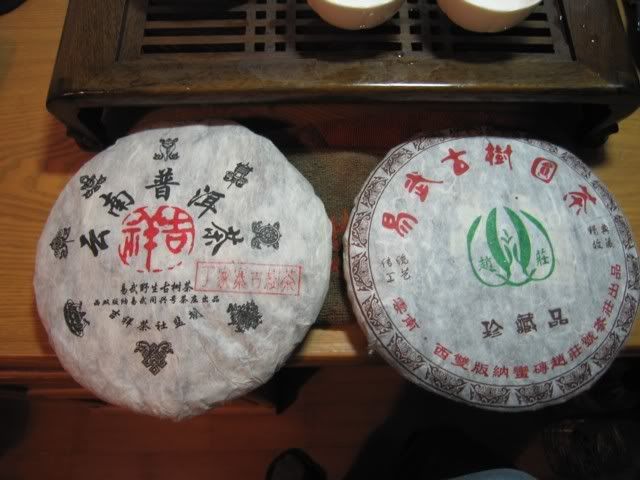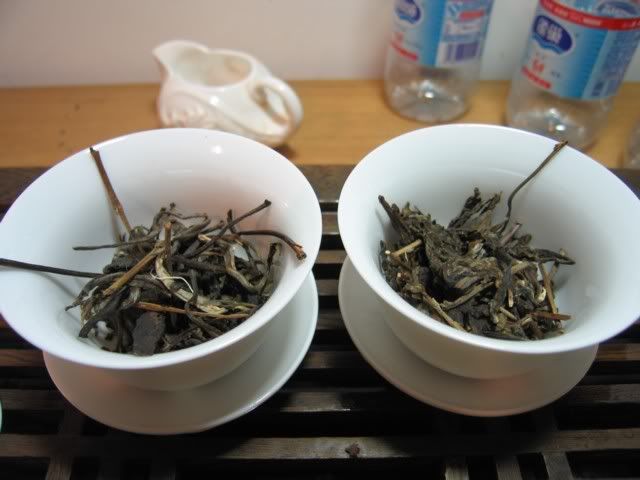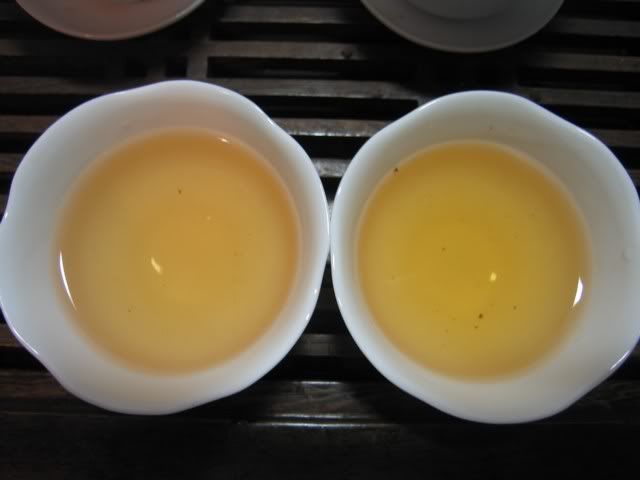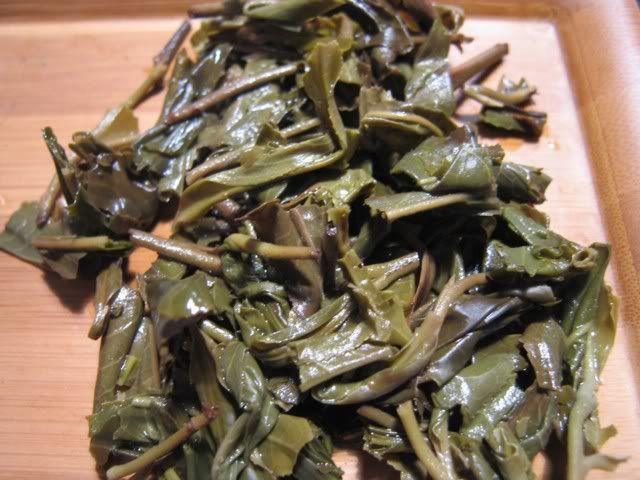A long entry today…. be warned.
As promised, I decided to taste two teas today using my new supplies. The two cakes are:

Both Yiwu fall production tea. The one on the left, funny enough, is the one that BBB tried to buy but had problems with. The one on the right is the one I got from the Yiwu girl, and unfortunately, I think it’s not on the market at all.
The front of the cake on the left (let’s call it the L cake) is in yesterday’s post. This is a shot of the back

And the R cake’s back — you’ve seen this before long time ago when I first tried this.

Lacking a scale, I tried to eyeball it

I brewed them with basically the same parameters — pouring water in one first, then the other, and then pouring them out in the same order. There are, of course, tiny variations, but that’s about the best you can do. The dry leaves of the L cake smell a little smokey. The R cake is more fragrant and lacking any smoke — mostly just floral notes.
This is what turned out first

The one on the right is a little darker, as you can see. It would remain darker for the rest of the brewings. At first, it’s probably because it ended up that a little more leaves were on the R cup than the L cup. I took some leaves out of the R cup after two or three infusions, but the colour differential (which isn’t going to be noticeable if I brewed them separately) remained. I think it can be partly explained by the slightly smaller and more broken leaves in the R sample — the cake is more compressed, so when I took pieces out the tea was a little more broken.
The taste…
L tastes a little smokey at first. The smoke would stay for about 7-8 infusions, under the 30/60/perpetual 30 rule (although later on I just brewed however long I wanted). It’s less sweet. The huigan is less obvious. R tastes more intense, the tea is probably a little stronger, with a sweeter taste and a much more obvious huigan. There was cooling in the throat, although since that is often a delayed reaction, I’m not sure which one was responsible.
In some ways, R is more immediately appealing, although I wonder if L might be longer lasting, and will taste just as good in the long run. It’s almost flavourless, in a way. The undertones are quite similar, both having that Yiwu taste, with R, again, being more up front about it. They are from different villages, so that might also account for some of the minor differences in taste. L is slightly more bitter. R is a little less, and the sweetness comes on almost immediately. Both are hardly bitter by normal standards.
A little later:

And even later (this one looks darker than the last because I left the water in for quite a while):

Finally:

The last picture is probably around infusion 15. Both still tastes like tea, although getting rather weak. I gave up and decided to take pics of the wet leaves.
L:

R:

L has more sticks, R has more leaves. This might also explain why L was more bitter than R, and R tasted a little more intense. R’s leaves also contained more buds, whereas L is mostly big leaves. Could this also have an effect on taste? It seems like it might. Maybe R is a mix of spring and fall leaves, instead of pure fall leaves. There are just a little too many small buds for it to be a creditable fall only cake, I think…
Some exemplary leaves — again comparing L and R:


All in all, a pretty interesting experiment. I think at least in terms of rebrewability, they are about equal. In terms of strength, intensity of flavour, and that kind of thing, R comes out a bit ahead of L. I think some of the answers might be supplied by the sort of leaves present in the sample. That, and the tiny regional variation, as well as whatever other factors (processing, etc).
Was it useful to have done this? I think so. Was it a little tough on the body? Yes. At one point, I was sweating a lot (this was after 3-4 cups). Even with the tiny gaiwan, I’m still drinking a lot of tea, and big tree tea is going to be strong.
I sort of want to get more of both, and see how they taste say 5 years down the line. It will be very valuable to have that sort of comparative experience to know exactly what sort of thing will age well. Unfortunately, it might be difficult to get my hands on more of either of them. This is intensely frustrating.
It’s sort of stiffening my resolve a bit to go to Yunnan next spring to find my own tea.
Meanwhile… I stuffed the leaves (almost all of them) back into a single gaiwan and trying to get more cups out of them. Shouldn’t let good tea go to waste. 🙂
Edit: I’m drinking some water right now, and somehow…. when I was breathing with the cup in “drinking” position, I could sort of smell the Yiwu….. ahhhhggg, I think it’s withdrawal.

 RSS - Posts
RSS - Posts
6 responses so far ↓
Phyllo // December 6, 2006 at 2:14 pm |
An interesting comparison! From the 2 side-by-side pics, R’s leaves look more jagged on the edges than L’s leaves, and R’s also have a slightly thicker midrib and more prominent veins than L’s. Do you know if those factors indicate anything about the trees, such as whether one is younger or older, plantation or semi-wild, etc.?
Thanks for sharing your experiment. 15 infusions x 2…that’s a lot of tea. You didn’t mention about their cha qi, but if you were sweating a lot, it must have been pretty good cha qi, I guess.
Phyllo // December 6, 2006 at 2:15 pm |
Ooops, please reverse the R with L, and vice versa in my comment above! I need to do an MRI.
MarshalN // December 6, 2006 at 2:33 pm |
Hmmm, it didn’t show so well in the pictures. Actually in the second side by side picture of the leaves, the R leaf has much more obvious veins, etc, than the L, which looks thin in comparison. So a reversal of the first picture. I thought that was interesting.
As for the whole “what kind of leaves are big tree leaves?” thing…. honestly, so far I have yet to figure out what exactly constitutes big tree leaves. The problem is, there are so many variables that are involved that basically all the characteristics can be “might have jagged edge, or smooth”, “might have hair, or not”, “might xxxxxxx”. There’s no defining characteristics, it seems, but maybe a combination of factors. It still goes back to the taste — you gotta taste the thing, and while I’m not good at telling the difference with precision, I am getting a little better than before, I think.
There’s also the problem that in any given batch, you’re bound to have leaves that are from different kinds of trees — some older, some younger. Even “big tree” varies a lot in definition. A tree that’s as tall as you can often be considered “big tree”. Go figure.
xcasper54x // December 7, 2006 at 9:17 am |
Hello MarshalN, totally unrelated to this post, but BBB is checking out some Nongxiang Tieguanyins at Best Tea House for me. I was wondering which one you think is the best of the ones you have tried?
MarshalN // December 7, 2006 at 11:11 am |
Hey
I am honestly not sure what to recommend you. Basically, the problem is that nongxiang runs the gamut from somewhat fired to very heavily fired, and I don’t know what you might like.
Also, since the batches are different every year (what I mean is, since year to year the tea varies a bit) unless I’ve tasted one of them, I can’t tell you for sure that it will be good. It’ll be silly to blow money on $30 of tea that turns out to be mediocre when, in fact, the $20 version is actually better. It happens a lot for BTH for their oolongs/TGY, because the pricing is based on the firing style, etc, not on the leaves’ quality per se.
The last problem is that I can’t remember what they are called in English — the Chinese names have very little to do with the English….
The retaste project 16: 2006 Fall Jixiang Chashe Yiwu Dingjiazhai | A Tea Addict's Journal // July 9, 2013 at 4:56 am |
[…] maybe half a dozen cakes from him, all pretty decent things. I’ve written about this tea some years ago. I think the main things to note now are as […]